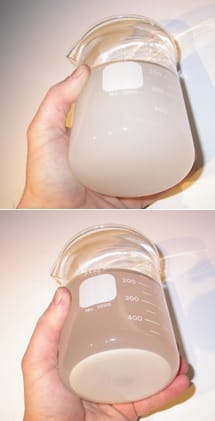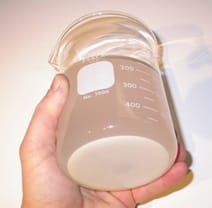From the publication Insecticide Basics for the Pest Management Professional
By Daniel R. Suiter, UGA Department of Entomology & Michael E. Scharf, UFL Department of Entomology and Nematology
Formulations commonly applied as liquid sprays are:
- emulsifiable concentrates (abbreviated as EC)
- wettable powders (WP)
- suspension concentrates (SC)
- microcaps (ME [microencapsulates] and CS [capsule suspensions])
These formulations must be diluted with water before they can be applied.
Emulsifiables are formulations that allow a water-insoluble insecticide to be suspended in water. Water and oil do not mix unless an emulsifying agent is added. When an emulsifier is added to a mixture of oil and water, microscopic droplets of oil are formed that disperse throughout the water. The resultant milky-white mixture is referred to as an emulsion.
Contact insecticides must be hydrophobic (insoluble in water) in order to penetrate the insect cuticle and/or interact with target sites. Although insoluble in water, most insecticides are soluble in oil or another solvent. To form an insecticide-active emulsion, the insecticide is dissolved in the solvent. When the emulsifier is then added, the resulting milky-white emulsion contains microscopic droplets of insecticide-impregnated solvent that become dispersed evenly throughout the water, as described in the previous paragraph. This resultant formulation can then be sprayed.
The droplets in emulsifiable formulations do not settle like suspensions and, therefore, require minimal agitation in comparison to formulations that are suspensions (wettable powders, microencapsulates, suspension concentrates).
Because emulsifiables readily absorb into skin, appropriate precautions should be used to minimize contact.

Wettable powder formulations are created by impregnating or coating a microscopic particle of an inert carrier (e.g., adsorptive clay, talc, etc.) with insecticide and various inert ingredients to enhance the wetting, spreading, and dispersing characteristics of the powder.
The inert ingredients (wetting agents) allow the dry powder to evenly disperse in and mix with water without clumping or caking.
Because wettable powders are true suspensions, constant agitation is required to keep the powder suspended in water.
Wettable powders do not readily absorb into skin, but care should be taken when using this formulation to avoid accidental inhalation.
Suspension concentrates can be considered wettable powders that have been packaged in liquid formulation. They consist of very small crystals of technical grade insecticide mixed with an extremely fine, inert dust, a small amount of water, and various other inert ingredients. The inert ingredients enhance the dispersion and mixing characteristics of the formulation when diluted with water.
Because suspension concentrates settle out of suspension, they require constant agitation (Figure 1).
Microencapsulated products are formed by encapsulating an insecticide in a microscopic, round, plastic capsule. The capsules are mixed with inert ingredients (dispersants, wetting agents, etc.) to keep them from clumping and to help the mixture flow more readily. The inert ingredients also facilitate storage and dispersion when diluted in water.
The capsule’s wall thickness determines the release rate of the insecticide to the outside environment. The insecticide seeps through the capsule’s wall and coats the outside of the capsule. As the insecticide disappears (degradation, evaporation, etc.) additional insecticide inside the capsule continues to coat the capsule surface. This process maintains a capsule that is constantly coated with a thin film of insecticide.
The manufacturer can change the characteristics of the capsule wall to slow (or accelerate) the release rate of the chemical from inside the capsule, thus altering the residual life of the treatment. Changing the characteristics of the capsule can alter the product’s odor (slower release rates result in less smell); protect the chemical from environmental degradation; influence the rate of kill by the insecticide (faster release rates mean a faster rate of kill); and reduce exposure to non-target organisms.
Because microcaps settle out of suspension, constant agitation is required.
